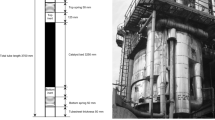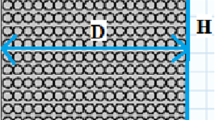Abstract
A recuperative reactor with a fixed porous bed for oxidization of organic impurities contained in air has been simulated. This reactor represents a system consisting of two coaxial tubes filled with a porous carcass mix. The influence of the dimensions of the reactor, the heat losses through its side wall, and the diameter of the filling-material balls on the maximum temperature realized in it, the efficiency of recuperation, and the position of the combustion front has been investigated. It has been established that the maximum temperature of the indicated reactor changes nonmonotonically with increase in the heat exchanges between its side wall and the environment. The parametric-investigation results obtained can be used for optimization of the design of recuperative reactors.
Similar content being viewed by others
References
Selecting the most appropriate HAP emission control technology, The Air Pollution Consultant, 3, Issue 2, 1–9 (1993).
Yu. Sh. Matros, A. S. Noskov, and V. A. Chumachenko, Catalytic Decontamination of the Waste Gases of Industrial Productions [in Russian], Nauka, Novosibirsk (1991), pp. 22–37.
F. Contarin, A. V. Saveliev, A. A. Fridman, and L. A. Kennedy, A reciprocal flow filtration combustor with embedded heat exchangers: numerical study, Int. J. Heat Mass Transfer, 46, 949–961 (2003).
L. A. Kennedy, A. A. Fridman, and A. V. Saveliev, Superadiabatic combustion in porous media: wave propagation, instabilities, new type of chemical reactor, Int. J. Fluid Mech. Res., 22, 1–26 (1995).
J. G. Hoffman, R. Echigo, H. Yoshida, and S. Tada, Experimental study on combustion in a porous media with a reciprocating flow system, Combust. Flame, 111, 32–46 (1997).
W. D. Binder and R. J. Martin, The destruction of air toxic emissions by flameless thermal oxidation, Incineration Conf., Knoxville, Tennessee (1993).
T. Takeno and K. Sato, An analytical study on excess enthalpy flames, Combust. Sci. Technol., 20, 73 (1979).
M. K. Drayton, A. V. Saveliev, L. A. Kennedy, A. A. Fridman, and Y. E. Li, Superadiabatic partial oxidation of methane in reciprocal and counterflow porous burners, in: Proc. 27th Int. Symp. on Combust., Pittsburg, PA (1998), pp. 1361–1367.
A. N. Migoun, A. P. Chernukho, and S. A. Zhdanok, Numerical modeling of reverse-flow catalytic reactor for methane partial oxidation, in: Proc. V Int. School-Seminar “Nonequilibrium Processes and Their Applications” [in Russian], Minsk (2000), pp. 131–135.
K. V. Dobrego and S. A. Zhdanok, Physics of Filtrational Combustion of Gases [in Russian], A. V. Luikov Heat and Mass Transfer Institute of the National Academy of Sciences of Belarus, Minsk (2002).
K. Hanamura, R. Echigo, and S. Zhdanok, Superadiabatic combustion in a porous medium, Int. J. Heat Mass Transfer, 36, No. 13, 3201–3209 (1993).
K. V. Dobrego, N. N. Gnesdilov, I. M. Kozlov, V. I. Bubnovich, and H. A. Gonzalez, Numerical investigation of the new regenerator-recuperator scheme of VOC oxidizer, Int. J. Heat Mass Transfer, 48, 4695–4703 (2005).
N. N. Gnezdilov, K. V. Dobrego, I. M. Kozlov, and E. S. Shmelev, Simulation and optimization of an organic-impurity oxidization reactor with a fixed porous bed and an electric heating element, Inzh.-Fiz. Zh., 79, No. 5, 3–10 (2006).
K. V. Dobrego, I. M. Kozlov, S. A. Zhdanok, and N. N. Gnesdilov, Modeling of diffusion filtration combustion radiative burner, Int. J. Heat Mass Transfer, 44, 3265–3272 (2001).
K. V. Dobrego, I. M. Kozlov, N. N. Gnesdilov, and V. V. Vasiliev, 2DBurner — Software Package for Gas Filtration Combustion Systems Simulation and Gas Non-Steady Flames Simulation [in Russian], Preprint No. 1 of the A. V. Luikov Heat and Mass Transfer Institute, Minsk (2004).
V. Ya. Basevich, A. A. Belyaev, and S. M. Frolov, “Global” kinetic mechanisms for calculating turbulent reacting flows. 1. A basic chemical process of heat release, Khim. Fiz., 17, No. 9, 117–129 (1998).
Author information
Authors and Affiliations
Additional information
__________
Translated from Inzhenerno-Fizicheskii Zhurnal, Vol. 79, No. 6, pp. 61–67, November–December, 2006.
Rights and permissions
About this article
Cite this article
Gnezdilov, N.N., Dobrego, K.V. & Kozlov, I.M. Parametric investigation of a recuperative reactor with a fixed porous bed for oxidization of organic impurities contained in air. J Eng Phys Thermophys 79, 1110–1116 (2006). https://doi.org/10.1007/s10891-006-0212-0
Received:
Issue Date:
DOI: https://doi.org/10.1007/s10891-006-0212-0




